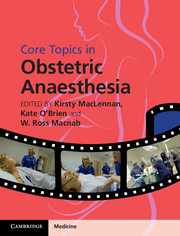Book contents
- Frontmatter
- Contents
- List of contributors
- Preface
- Section 1 Basic science, epidemiology and service organization
- Section 2 Obstetric aspects
- Section 3 Provision of anaesthesia
- Section 4 Medical conditions in pregnancy
- 14 Hypertension in pregnancy, pre-eclampsia and eclampsia
- 15 Sepsis and influenza in pregnancy
- 16 Cardiac disease in pregnancy
- 17 Respiratory disease in pregnancy
- 18 Obesity and ultrasonography for central neuraxial blocks
- 19 Endocrine disease in pregnancy including diabetes mellitus, thyroid and adrenal disease
- 20 Renal disease
- 21 Haematologic disease in pregnancy
- 22 Neurosurgical and neurological disease in pregnancy
- 23 Immunology, including testing and management of allergy during pregnancy
- 24 HIV and infectious disease in pregnancy, including herpes, syphilis and hepatitis
- Section 5 Postpartum complications and obstetric emergencies
- Section 6 Service organization
- Index
- Plate section
- References
19 - Endocrine disease in pregnancy including diabetes mellitus, thyroid and adrenal disease
from Section 4 - Medical conditions in pregnancy
Published online by Cambridge University Press: 05 December 2015
- Frontmatter
- Contents
- List of contributors
- Preface
- Section 1 Basic science, epidemiology and service organization
- Section 2 Obstetric aspects
- Section 3 Provision of anaesthesia
- Section 4 Medical conditions in pregnancy
- 14 Hypertension in pregnancy, pre-eclampsia and eclampsia
- 15 Sepsis and influenza in pregnancy
- 16 Cardiac disease in pregnancy
- 17 Respiratory disease in pregnancy
- 18 Obesity and ultrasonography for central neuraxial blocks
- 19 Endocrine disease in pregnancy including diabetes mellitus, thyroid and adrenal disease
- 20 Renal disease
- 21 Haematologic disease in pregnancy
- 22 Neurosurgical and neurological disease in pregnancy
- 23 Immunology, including testing and management of allergy during pregnancy
- 24 HIV and infectious disease in pregnancy, including herpes, syphilis and hepatitis
- Section 5 Postpartum complications and obstetric emergencies
- Section 6 Service organization
- Index
- Plate section
- References
Summary
Diabetes
Introduction
Diabetes mellitus (DM) is a common and growing problem, affecting approximately 650,000 pregnancies in England and Wales each year (representing 2–5% of the obstetric population). Women with diabetes have an increased risk of both fetal and maternal complications, and of requiring anaesthetic intervention. Close monitoring and treatment during pregnancy, and careful anaesthetic management during labour and delivery, can reduce these risks and improve outcomes for both mother and baby.
Classification
DM is a multisystem disorder of carbohydrate metabolism, which can result from a number of distinct pathophysiological processes. Around 7.5% of pregnancies complicated by diabetes are due to type 1 and 5% due to type 2 diabetes. Gestational diabetes (GDM) accounts for the remaining 87.5%.
Type 1
Type 1 DM is attributable to an absolute lack of insulin production and secretion by the pancreatic β cells of the Islets of Langerhans. It is primarily an autoimmune disorder, although genetic and environmental factors also play a role. It accounts for around 10% of all DM. There is an association with other autoimmune conditions, including hypothyroidism.
Type 2
Type 2 DM is caused by a combination of both relative lack of insulin secretion and insulin resistance in target tissues. It accounts for 90% of all DM cases and is primarily associated with obesity. As such, its prevalence in both obstetric and non-obstetric populations is increasing and this is particularly so amongst several ethnic groups (including people of African, black Caribbean, South Asian, Middle Eastern and Chinese family origin).
Gestational diabetes mellitus
Gestational diabetes (GDM) is defined as glucose intolerance, which is first identified during pregnancy. Insulin resistance is known to increase progressively during the second and third trimesters of pregnancy due to an increase in counter-regulatory hormones (including placental lactogen, placental growth hormone, cortisol and progesterone). GDM may therefore be thought of as a preclinical state of glucose intolerance unmasked by the physiological changes in pregnancy. For most mothers glucose levels return to normal, but there is an increased risk of subsequent type 2 diabetes in women diagnosed with GDM.
- Type
- Chapter
- Information
- Core Topics in Obstetric Anaesthesia , pp. 138 - 145Publisher: Cambridge University PressPrint publication year: 2015



